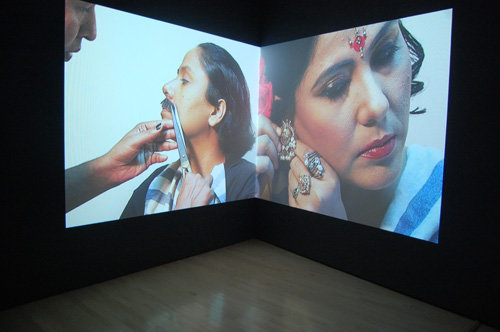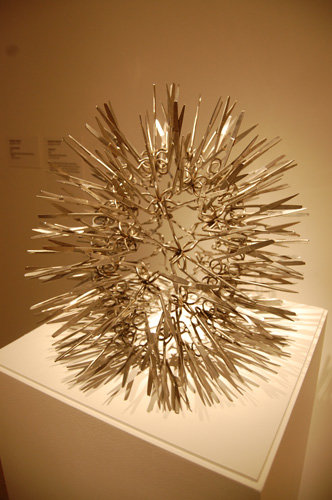
“The Artist as Activist,” a new exhibit at the Broad Art Museum featuring the art of Bangladeshi artists Tayeba Begum Lipi and Mahbubur Rahman, meets some of the country’s biggest social issues head-on. True to its title, the exhibit challenges traditional ideas of marriage, nationality and religion.
“It’s not a quiet show,” said Broad Art Museum curator Caitlín Doherty. “It doesn’t sit on the fence.”
Rahman and Lipi, a husband and wife duo, are two of Bangladesh’s most prominent contemporary artists. This exhibit is the first major museum exhibition to bring the work of the two artists together.
“This is the largest show of our lives,” Lipi said.
The exhibit is divided in three sections: one section for each of the artists as individuals and one section for their combined works.

Lipi’s section is constructed as a series of three rooms. Doherty designed the rooms to become increasingly intimate, both in size and subject matter, as one moves through the section.
The first room features several domestic items, such as a sewing machine table or a mattress, constructed from eye-catching stainless steel. A closer examination reveals that the steel is actually a sheet of razor blades.
“I like using sharp materials,” Lipi explained, “Sharp and shiny.”
On one hand, she said, the razors represent an element of danger. In Bangledeshi culture, subjects like domestic abuse are rarely discussed in public.
“There’s a lot of violence you don’t see,” Lipi said.
But the steel also represents strength, or what Lipi calls the “hidden power of women.” While the steel is shiny and attractive, it is rigid and resilient when pressed. This type of quiet perseverance is needed in a society that affords few rights to women.
As you move into the next room, a pair of video works take on issues of marriage and religion. The next room features pieces that address issues of motherhood and femininity.
Where Lipi’s style is introspective and subtle, Rahman’s is brash and direct. His diverse works take up the largest upstairs gallery.
Several themes emerge in this section. A series of prints deals with issues of national identity, with self portraits of the artist seemingly hanging in limbo drawn in charcoal over government documents. Bangladesh’s turbulent 20th century included stints as a British colony and then a part of Pakistan before the country gained its independence in the early 1970s.
Like Lipi, Rahman uses sharpened steel as a thematic element — in his case, surgical scissors. Rahman, who had a finger partially amputated as a child, is fascinated by surgical scissors. The scissors also have a meta phorical significance, representing the way Bangladesh has been cut away from different national affiliations.
“The purpose of the scissors is to cut the body,” Rahman explained. “It’s about making partitions, taking something out of the body.”
Other works deal with the 2013 Rana Plaza disaster, where over 1,000 workers were killed in a factory collapse. A set of prints comments on Rahman’s difficulty traveling in the wake of terrorist attacks.
Marriage is an important theme in both artists’ work. In Bangladesh, especially in small villages and rural areas, arranged marriages are still common.
“If you’re a man, you have all the power,” Lipi explained. “In some situations, men will get photos of 50 women to choose from.”
“I Wed Myself,” a creative video piece in Lipi’s section of the exhibit, depicts a bride and groom preparing for their wedding — with Lipi playing both parts. It functions as a sort of escapist fantasy, with the bride avoiding the uncertainty of an arranged marriage by marrying herself.
Other works by Rahman draw parallels between arranged marriages and the purchase of cattle. “Toys Are Watching Toys,” a multi-media work by the combined artists, juxtaposes a marriage scene against a video of animal sacrifice. The bride is offered up as a sacrificial animal to her husband.
(This piece is graphic and quite shocking. The installation is blocked off from the rest of the exhibit, and a sign warns viewers about the piece’s content.)
The final section, featuring combined works by the artists, addresses the struggles of transgender people in Bangladesh. A pair of video works, a sculpture and a light-box piece all focus on a transgender woman named Annonya and her day-to-day life in Bangladesh.
The exhibit stands in contrast to Andrew Sendor’s exhibit, which is housed downstairs and across the hallway. Where Sendor’s hyper-realistic paintings are purposely opaque, Rahman and Lipi’s works have a clear agenda.
“Our activism, our artwork, says something. We want to change the world,” Rahman said. “We want to change the mentality of people, then things will change.
“The Artist as Activist: Tayeba Begum Lipi and Mahbubar Rahman”
On display through Aug. 7 FREE
Eli and Edythe Broad Art Museum 547 E. Circle Drive, East Lansing (517) 884-4800, broadmuseum.msu.edu
Support City Pulse - Donate Today!
Comments
No comments on this item Please log in to comment by clicking here